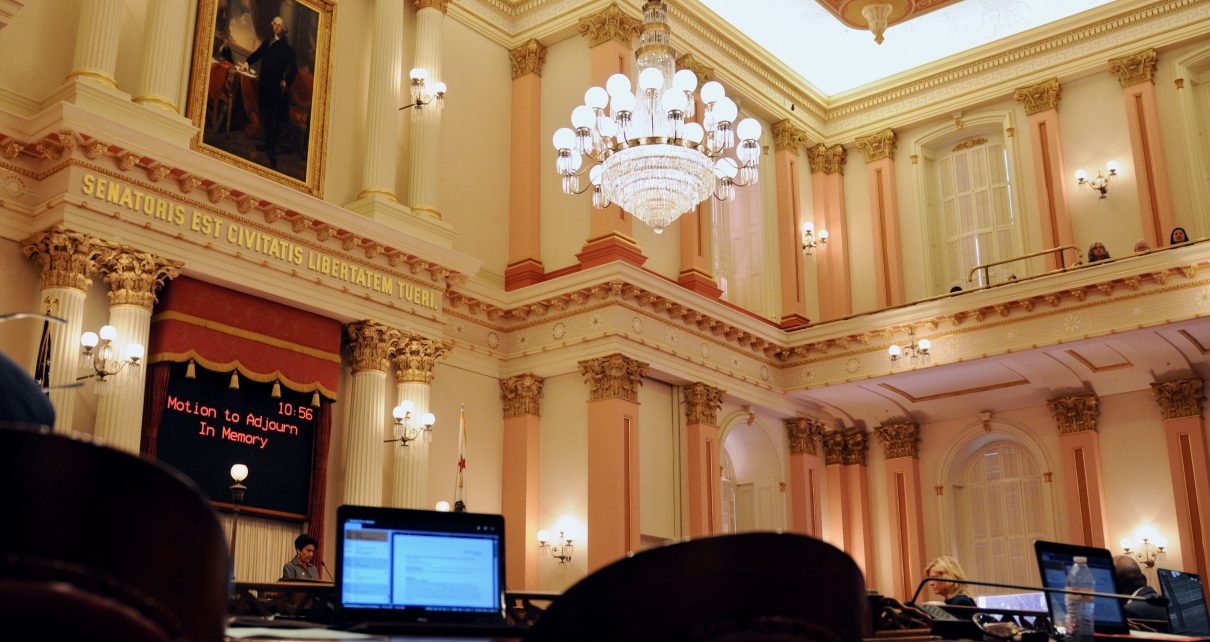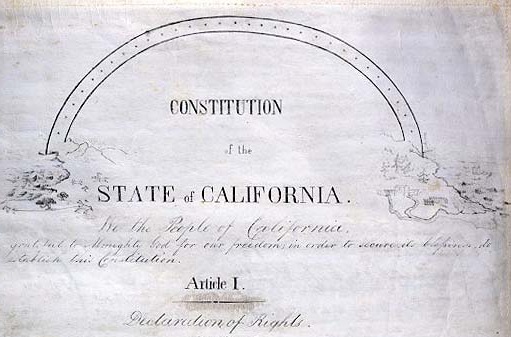
California Senate Chambers. (Photo: Kevin Sanders for California Globe)
Finding Legislative Intent with Daily Journal Letters After the 72-Hour in Print Rule
The letters must be on the legislator’s letterhead and signed by that legislator
By Chris Micheli, December 26, 2019 8:17 am
By Kevin Duewel and Chris Micheli
In determining the intent of the state Legislature in enacting specific laws, California courts have historically taken a limited view of the methods that can be used to determine legislative intent. One such method is to review any letters the bill’s author submitted to either the Assembly Daily Journal or the Senate Daily Journal “letters to the journal”). The use of these letters of the journal is challenged by the 72-Hour in Print Rule discussed below.
Letters to the Journal
By way of background, both houses of the Legislature provide a process by which a legislator can publish a letter in either the Assembly Daily Journal (generally for the author of a bill in the Assembly) or the Senate Daily Journal (generally for the author of a bill in the Senate) in order to explain the intent behind the bill. These “letters to the journal” are a formal matter. The letters must be on the legislator’s letterhead and signed by that legislator.
The Assembly and Senate may publish these letters in the respective journals for several possible reasons, such as to explain an ambiguity in the bill, to explain particular changes in the law, or for other reasons.
Before the clerks publish the letter, it is general custom and practice for the respective leadership of both majority and minority parties to review the contents of the letter and determine whether they have any objections to its contents. Committee consultants may request revisions to the letter. The Assembly Speaker’s office reviews and approves letters, as well as the Senate President pro tempore’s office. Usually the two minority leaders in each house provide similar review and approval.
If approval is not received by both sides of the aisle, then the legislator can request that the letter be printed in the respective journal with a roll call vote of that house. If that occurs, then a majority of the legislators in the respective house (41 of the 80 Assembly Members or 21 of the 40 Senators) must vote to print the letter. Accordingly, letters to the journal are usually printed with unanimous consent in the respective house, but ultimately only a majority of the house must approve it.
When considering the intent of the Legislature, state courts do not generally consider statements by individual legislators. (In re Application of Lavine (1935) 2 Cal.2d 324.) Even when the individual legislator is the author of a bill, courts cannot guarantee that the other members of the Legislature who voted for the bill shared the same views about the bill as the author. (In re Marriage of Bouquet (1976) 16 Cal.3d 583, 590.)
For this reason, courts generally will only consider letters to the journal (i.e., letters of intent published by one or both of the houses of the legislature) when the expression of intent appears to convey more than merely a personal view of the proponent of the bill. (Roberts v. City of Palmdale (1993) 5 Cal.4th 363, 378.)
The Supreme Court assessed the legal relevance of letters to the journal in In re Marriage of Bouquet. In that case, the Court considered a Senate resolution incorporating a letter written to the President Pro Tempore of the Senate by a member of the Assembly, the author of the amendment at issue in the case. The Court held that a statement from a legislator is entitled to consideration when it reiterates the arguments leading up to the adoption of the legislation, rather than merely personal views. (Id. at 590.)
The Supreme Court has since made clear that Bouquet referred to the admissibility of the evidence rather than the weight to be given. (California Teachers Assn. v. San Diego Community College Dist. (1981) 28 Cal.3d 692.) While letters to the journal are admissible, they exist on a spectrum of indicia of legislative intent. In Bouquet, the Supreme Court reasoned:
“To say that the letter properly bears upon the issue of legislative intent is not to hold that it necessarily concludes that issue. In many cases the indicia of intent are in conflict, and the proper construction of the statute requires us to impute weight to expressions of intent in accord with their probative value. Thus, a motion to print a letter of legislative intent commands less respect than a formal resolution of legislative intent. Likewise, an individual legislator’s recount of the argument preceding the passage of a bill probably merits less weight than extensive committee reports on the bill or a former record of legislative debates.”
72-Hour in Print Rule
In 2016, California voters adopted Proposition 54, which amended Article IV, Section 8(b) of the California Constitution. Proposition 54 prohibits the Legislature from passing any bill unless it has been in print and published on the Internet for at least 72 hours before the vote.
To complicate the Assembly debate, the Senate insisted that it would comply with the 72-Hours in Print Rule (note that the requirement is based upon hours, despite some observers improperly calling it a “three-day in print” rule), but the Assembly was of the legal opinion that Proposition 54 does not apply to the house-of-origin deadline. The Senate took the same position, but chose to comply with the 72-Hours in Print Rule with the house-of-origin deadline nonetheless.
The Assembly adopted internal rules, Assembly Rules 76 and 46, to put Proposition 54 into effect. The Senate rules, in contrast, do not contain any mention of Proposition 54’s provisions. Assembly Rules 76 and 46 limit Proposition 54 in two ways:
First, Proposition 54 only applies to Senate bills in the Assembly that were amended in the Assembly. Second, Proposition 54 does not apply to resolutions or constitutional amendments. This is because of language in Proposition 54 to the effect of: a bill “…ultimately becom[ing] a statute.” Naturally, neither a resolution nor a constitutional amendment by the Legislature ultimately becomes a statute.
In the Senate, journal letters are usually published on the day that the bill was taken up for final consideration and vote on the Senate Floor. This practice ensures that adoption of the letter to the journal coincides with the bill’s final vote, but still unclear whether the letter to the journal was shared with the rest of the Senate.
On the other hand, in the Assembly, journal letters are published at the last day of session, as one of the final actions before the house adjourns. As such, a letter to the journal could be adopted the same day, or as much as a week or more after the final floor vote on a bill in the Assembly.
Legislative Intent
From the case law discussed above, there are several questions to ask when evaluating the persuasiveness of letters to the journal, particularly letters to the journal submitted near (or after) the 72-hour deadline.
Letters to the journal will be stronger indicia of intent when signed off by both the committee and minority consultants and passed by unanimous consent. (People v. Ramos (1996) 50 Cal.App.4th 810, 821, fn. 12.) With the 72-hour deadline, a member may not have time to seek feedback from both the committee and minority consultants. If there is not enough time to have leadership, committee, and minority consultants sign off, or for only leadership and committee consultants from one party to sign off, the letter will not hold up as well in court.
Unanimity between the houses is also persuasive to the courts, such as when courts have letters both from authors in both the house of origin and the second house. (Roberts v. City of Palmdale (1993) 5 Cal.4th 363, 378.) Submission of a letter to the journal in the house of origin, and then again by the author in the second house will be stronger indicia of legislative intent than a letter to journal printed near (or after) the 72-hour deadline only in the second house.
The most significant challenge with letters to the journal near (or after) the 72-hour deadline will be ensuring that letters to the journal are made available to the entire Legislature. Letters not practically available to the entire Legislature are not be as strong indicia as letters that were available prior to the legislative vote (White v. Ultramar (1999) 21 Cal.4th 563, 581, fn. 2), and that were exposed to public view. (California Teachers Assn. v. San Diego Community College Dist. (1981) 28 Cal.3d 692, 701.
Letters to the journal printed only days before floor vote are less likely to have been taken into account by members before they cast their votes, especially when that floor vote is at the house of origin deadline or the end of legislative session.

Kevin Duewel is an attorney practicing small business and real estate law in Folsom, California. Chris Micheli is a Principal with the government relations firm of Aprea & Micheli, Inc. Both are graduates of McGeorge School of Law.
- Enforcement of Judgments in California - December 13, 2025
- General Provisions Related to Family Law Support - December 13, 2025
- Petitions for Forming Harbor Districts in California - December 12, 2025




